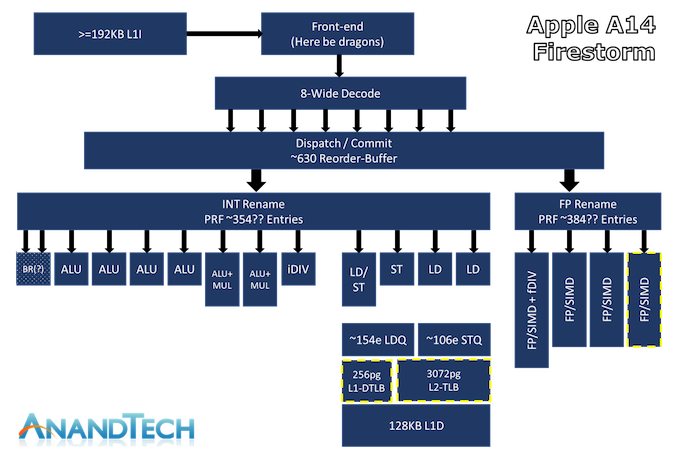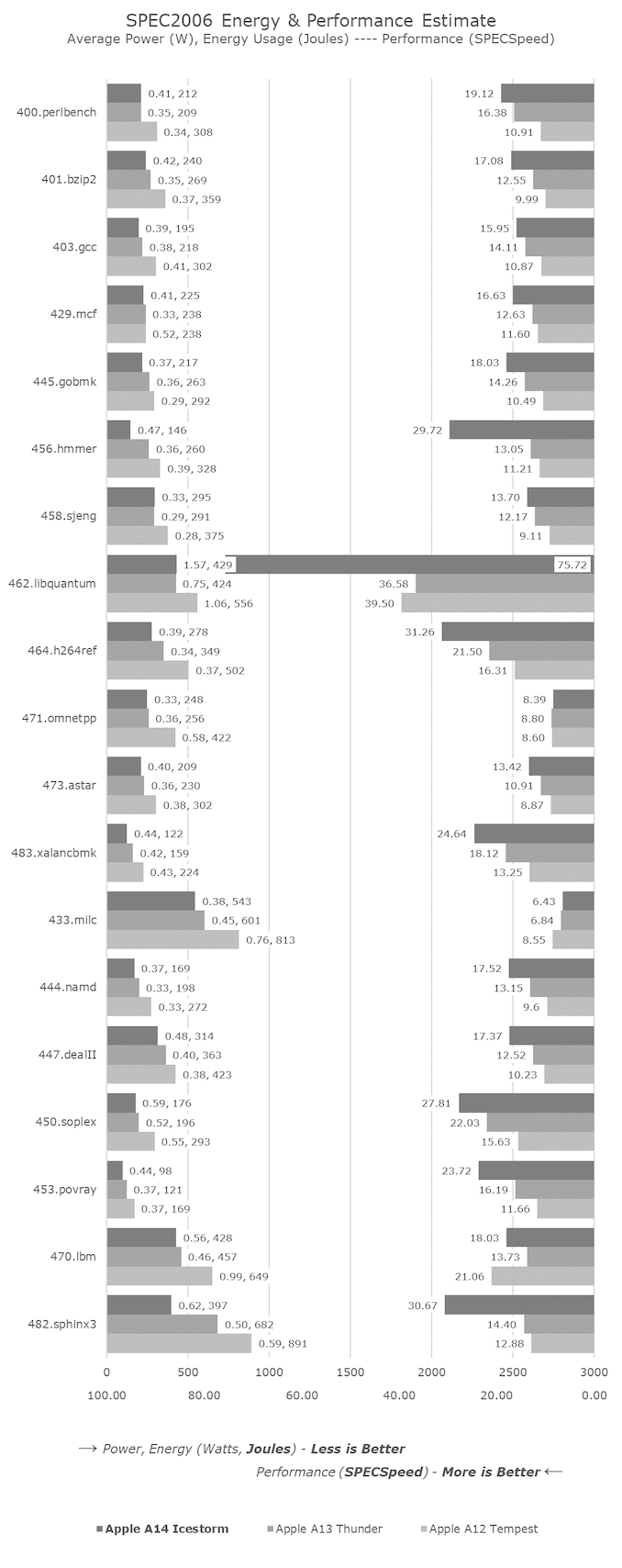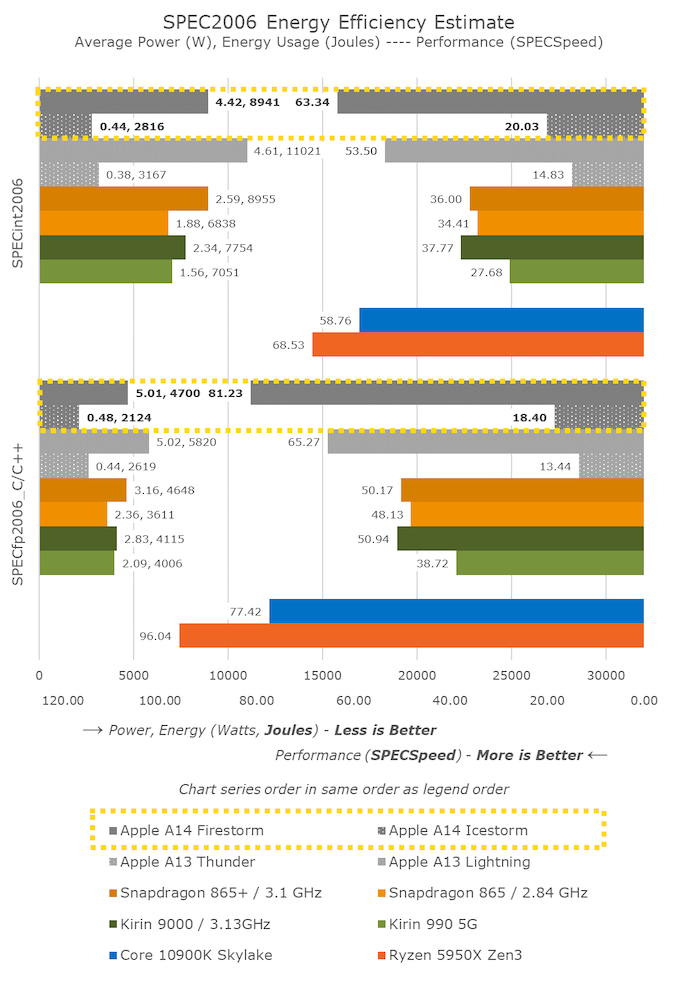The iPhone 12 & 12 Pro Review: New Design and Diminishing Returns
by Andrei Frumusanu on November 30, 2020 8:30 AM EST- Posted in
- Mobile
- Apple
- Smartphones
- Apple A14
- iPhone 12
- iPhone 12 Pro
The Apple A14 SoC: Firestorm & Icestorm
The new Apple A14 is the company’s newest mobile SoC and sits at the heart of the new iPhone 12 series. The new chip is the industry’s first commercial 5nm manufactured chip from TSMC, alongside the now no longer manufactured Kirin 9000.
Inside the A14 we find two big performance cores dubbed “Firestorm” and four efficiency cores called “Icestorm”, making this a 2+4 heterogeneous CPU SoC. Alongside the CPUs, we also find a 4-core GPU. Unfortunately this year it seems like we haven’t seen a public die shot of the A14, though Apple themselves published a shot of the M1 during their announcement event.
| Maximum Frequency vs Loaded Threads Per-Core Maximum MHz |
||||||
| Apple A13 | 1 | 2 | 3 | 4 | 5 | 6 |
| Performance 1 | 2666 | 2590 | 2590 | 2590 | 2590 | 2590 |
| Performance 2 | 2590 | 2590 | 2590 | 2590 | 2590 | |
| Efficiency 1 | 1728 | 1728 | 1728 | 1728 | ||
| Efficiency 2 | 1728 | 1728 | 1728 | |||
| Efficiency 3 | 1728 | 1728 | ||||
| Efficiency 4 | 1728 | |||||
| Apple A14 | 1 | 2 | 3 | 4 | 5 | 6 |
| Performance 1 | 2998 | 2890 | 2890 | 2890 | 2890 | 2890 |
| Performance 2 | 2890 | 2890 | 2890 | 2890 | 2890 | |
| Efficiency 1 | 1823 | 1823 | 1823 | 1823 | ||
| Efficiency 2 | 1823 | 1823 | 1823 | |||
| Efficiency 3 | 1823 | 1823 | ||||
| Efficiency 4 | 1823 | |||||
The new A14 raises the clock speeds of the CPU by a good amount, now essentially reaching 3GHz on the large performance cores in single-threaded scenarios. Once a second big cores come on this reduces to 2.89GHz and stays there even in heavier multi-threaded workloads. The efficiency cores land in at 1823MHz now, roughly a 100MHz boost over the A13, but we do know that in power unconstrained scenarios they can reach quite higher, such as 2064MHz employed on the M1.
The summary is that in this generation, Apple progresses the design further and making it wider than before, increasing the ROB size from 560 to 630, having significantly larger L1 DTLB which has now doubled in size from 128 pages to 256 pages, and increasing the L2 TLB from 2048 pages to 3072 pages. It’s particularly on the part of the floating point and vector execution units where the new Firestorm cores saw most of the design changes this year through the introduction of a 4th pipeline unit, essentially increasing the execution capabilities of this part of the design by 33%. On the integer side of the CPU, things have remained relatively the same with only minor changes, and the Firestorm cores continue on with the sale 192KB L1 I-cache and 128 L1 D-cache and 8MB of shared L2 amongst the two cores.
What we didn’t cover in more detail in the M1 piece was the new small efficiency cores. The Icestorm design is actually a quite major leap for Apple as it sees the introduction of a third integer ALU pipeline, and a full second FP/SIMD pipeline, vastly increasing the execution capabilities of this core. At this point it would be wrong to call it a “small” core anymore as it now essentially matches the big core designs from Arm from a few years ago, being similar in complexity as an A75.
Looking at the generational improvements of the efficiency cores we can see that Apple is indeed showcasing performance increases beyond that of just the increased 100MHz of the cores, with substantial upgrades across the workload spectrum.
Especially the floating-point workloads of the SPEC suite see very large improvements, exactly in the tests which are more execution heavy such as 453.povray or 482.sphinx3.
Apple still continues to limit the absolute performance of the efficiency cores when they are the only allowing the memory controller to not scale up to a higher frequency, meaning that the scores here in isolation are posting worse performance than in a normal more varied real-world scenario where the big CPU cores or the GPU would also be active, hence the scores aren’t directly comparable to other measurements we’ve made.
Overall, the new A14 is massively impressive and grows the performance gap compared to the competition. Apple has now reached higher single-threaded performance within their phone SoCs than what Intel can deliver in any of their designs, whilst only losing out to the desktop variants of AMD’s new Zen3 processors.
What’s important to note here is that Apple’s performance increase this generation did not come at a cost of increased power consumption, as the designers were able to leverage the microarchitectural improvements and the new process node – actually reaching either power parity or a small power reduction compared to the 7nm based A13. This means that the performance increases this generation also results in an energy efficiency increase for the design, with the A14 using notably less energy to complete a workload.
I’ve included the efficiency cores in the chart here to showcase that they’re not weak at all. The performance showcased here roughly matches a 2.2GHz Cortex-A76 which is essentially 4x faster than the performance of any other mobile SoC today which relies on Cortex-A55 cores, all while using roughly the same amount of system power and having 3x the power efficiency.













101 Comments
View All Comments
Ranger1065 - Wednesday, December 2, 2020 - link
I understand some members of your staff have problems, but this is ridiculous. In the interests of self preservation, isn't it time to get a GPU review done?29a - Wednesday, December 2, 2020 - link
Let me guess, no 3060 ti review?zeeBomb - Thursday, December 3, 2020 - link
that's tough!!!Frantisek - Friday, December 4, 2020 - link
Phones looks simmilar. Difference is much bigger then you picture even it does not look like that in normal use. Let see all differences.128 GB so real difference is 150 (130) USD
6 GB RAM
Telephoto: ƒ/2.0 aperture with OIS
2x optical zoom in, 2x optical zoom out; 4x optical zoom range
Digital zoom up to 10x
Lidar
Night mode portraits enabled by LiDAR Scanner
Apple ProRAW
Dolby Vision recording up to 60 fps
Durable steel frame you do not preffere
Brighter display
I think RAM, extra lens with OIS, Lidar and brighter screen can easily justify hugher cost.
And 100 USD for Max is really small difference for bigger screen and battery, better image sensor with extra stabilisation when we speak in Apple prices.
I hever had rounded phone so can not comment your feelings from flat edges. ... Sorry I had 3/3GS but it so long time ago and were quite bulky.
I would try to compare those phones in cases as many ppl wear them anyway.
s.yu - Friday, December 4, 2020 - link
Not exciting at all...Personally that move back to the iP4 design is the biggest "upgrade", as I've always felt that to be more premium, just like Razer etc. are all making their laptops more boxy. The camera would be more of a sidegrade.sharathc - Friday, December 4, 2020 - link
Boring 🙄iphonebestgamephone - Sunday, December 6, 2020 - link
More exciting than whatever you are doing, atleast.gerard143 - Thursday, January 28, 2021 - link
Outstanding review! Seriously, props to you for not being one of those Apple can do no wrong reviewers.You hit the nail on the head about the regression to square edges and the fingerprint magnet stainless steel.
The sqaure edges are a massive step backwards. I hate my 12 pro because of it. The stainless looks like garbage and is heavy. I’d prefer alum and rounded edges. When I hold my XS in my hand again it feels amazing compared to the 12 pro.
I feel your review was very accurate and well written. Great job!
mobilecampus - Monday, September 6, 2021 - link
hi, this is very helpful article on iPhone 12 and 12 pro, I only say you that if you want to any thing about iPhones mobile or other company mobile to must visit our store, I run a big shop with name of <a herf="https://www.facebook.com/MobileCampusEarlwood/&quo... Campus Engadine</a> in Australia also have multiple branches on different location,Thanksmobilecampus - Wednesday, October 6, 2021 - link
SmartphoneRepair is a one-stop-shop for mobile repairing services, located in Caringbah, New South Wales, Australia.Our techies are highly trained and have expertise in mobile fixing. Our shop is equipped with the latest toolkits which ensure our quality services.
We deliver quality-oriented services under a fast return policy with 3 Months warranty.
We have expertise in repairing all leading brand mobiles like iPhone, Samsung, Blackberry, Nokia, Sony Ericsson, Mike Iden, and HTC.
Our services consist of free estimates to fast repair. We offer screen replacement, battery replacement, water damage repair and charging port.
Customer satisfaction is our priority. All accessories are available including batteries, chargers, headphones etc
https://smartfonerepairs.com.au/